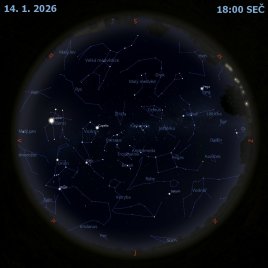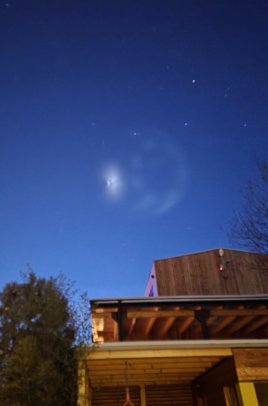Zbytek supernovy Gumova mlhovina

Uznání a copyright: Victor Lima
Přestože je Gumova mlhovina nejbližším zbytkem supernovy, tak je obtížné ji spatřit. Mlhovina na obloze zabírá asi 40 stupňů, jeví se velká a slabá, takže se snadno ztratí v šumu jasného a komplexního pozadí. Gumova mlhovina je pěkně zvýrazněná v červené emisi vpravo na širokoúhlém snímku pořízeném jedinou expozicí koncem května. a snímku je též v popředí vidět poušť Atacama v Chile, mlhovina v Lodním kýlu (Carina) v rovině naší Galaxie Mléčné dráhy, která úhlopříčně probíhá dolů shora vlevo a sousední galaxie Velké Magellanovo mračno (LMC). Gumova mlhovina je tak blízko, že jsme mnohem blíže jejímu čelnímu okraji, než jsme ke vzdálenému okraji ve vzdálenostech 450 a 1500 světelných roků. Tato komplikovaná mlhovina se nachází v souhvězdích Lodní zádi (Puppis) a Plachet (Vela). O Gumově mlhovině toho zůstává mnoho neznámého včetně načasování, a dokonce i počtu výbuchů supernov, které stály u jejího zrodu.
Seznam odkazů v popisu
- APOD: Supernova Remnants
- Github.io: Angle meter
- APOD: 2000-04-12 Místní bublina a galaktické sousedství
- APOD: 2018-05-24 Rozsah Gumovy mlhoviny
- Youtu.be: Atacama Desert / 4k Drone Video
- Wikipedia: Chile
- APOD: 2022-04-25 Velká mlhovina v Lodním kýlu
- APOD: 2022-08-17 __Galaxie_Mléčné_dráhy_
- APOD: 2019-09-05 Velké Magellanovo mračno
- Wikipedia: Gum_Nebula
- StaticFlickr.com: Foto: Psí čenich :-)
- Harvard.edu: Chandra: Note on Cosmic Distances
- Harvard.edu: Kinematics of the ionized gas in Puppis-Vela including the GUM nebula.
- Wikipedia: Constellation
- Wikipedia: Puppis
- Harvard.edu: Chandra: Vela (the sail)
- Harvard.edu: The Gum nebula: an old supernova remnant ionized by Zeta Puppis and Gamma Velorum?
- NASA: What Is a Supernova?
NASA Official: Phillip Newman Specific rights apply. NASA Web Privacy Policy and Important Notices
A service of: ASD at NASA / GSFC & Michigan Tech. U.
Odkaz na originální APOD


